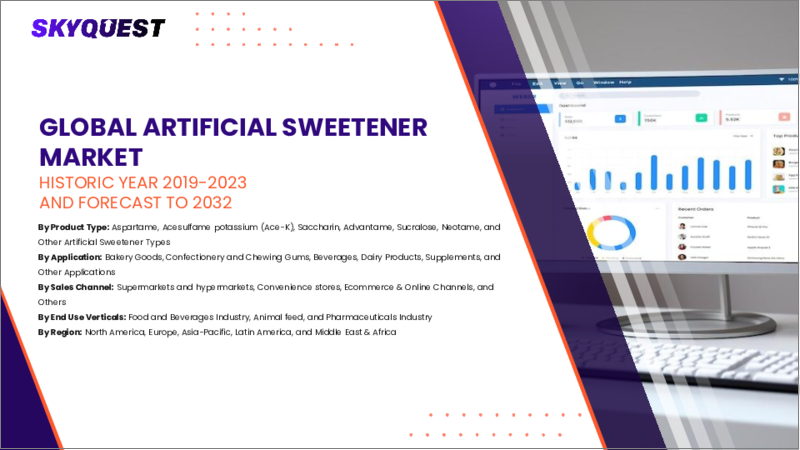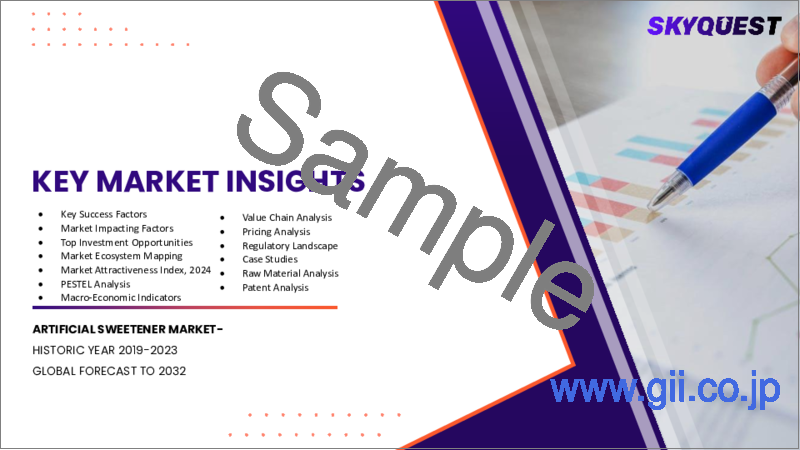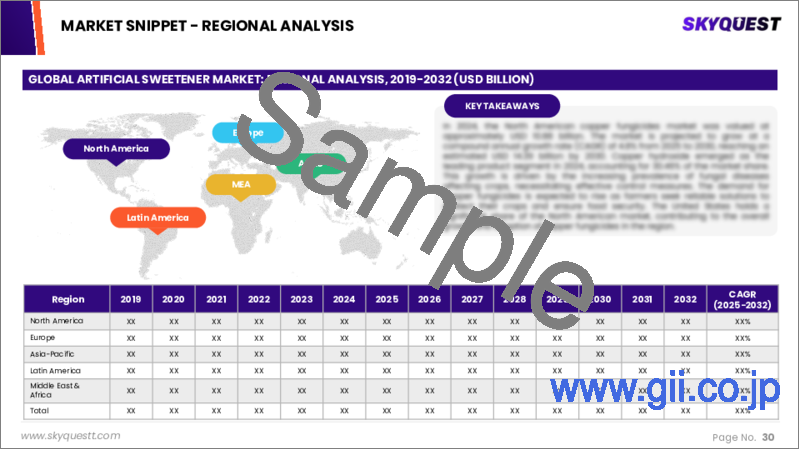|
|
市場調査レポート
商品コード
1614869
人工甘味料の市場規模・シェア・成長分析 (製品種類別、用途別、流通チャネル別、地域別):産業予測 (2024~2031年)Artificial Sweetener Market Size, Share, Growth Analysis, By Product Type (Sucralose, Aspartame), By Application (Beverages, bakery), By Distribution channels, By Region - Industry Forecast 2024-2031 |
||||||
|
|||||||
| 人工甘味料の市場規模・シェア・成長分析 (製品種類別、用途別、流通チャネル別、地域別):産業予測 (2024~2031年) |
|
出版日: 2024年12月16日
発行: SkyQuest
ページ情報: 英文 261 Pages
納期: 3~5営業日
|
全表示
- 概要
- 目次
人工甘味料の市場規模は2022年に21億米ドルとなり、予測期間(2024-2031年)のCAGRは3%で、2023年の21億6,000万米ドルから2031年には27億4,000万米ドルに成長する見通しです。
世界の人工甘味料市場は、健康意識の高まりと肥満や糖尿病に対する懸念の高まりによって大きな成長を遂げています。消費者が低カロリーやゼロカロリーの甘味料を求める中、人工甘味料は様々な食品や食品・飲料においてカロリーを追加することなく甘味を提供するために不可欠なものとなっています。この市場を後押ししているのは、健康問題の有病率の上昇と、より健康的な食品選択へのシフトです。しかし、味に対する消費者の認識や安全性に関する規制上の制約など、課題も残っています。主な動向としては、革新的な天然ベースの甘味料の出現や、風味プロファイルの強化への注目が挙げられます。健康志向の高まり、未開拓の新興経済国、eコマースの台頭により、人工甘味料市場の拡大機会は豊富にあります。
目次
イントロダクション
- 分析目的
- 市場範囲
- 定義
分析手法
- 情報調達
- 二次・一次データの手法
- 市場規模予測
- 市場の想定と制限
エグゼクティブサマリー
- 市場の概要と展望
- 需給動向の分析
- セグメント別の機会分析
市場力学と展望
- 市場概要
- 市場規模
- 市場力学
- 促進要因と機会
- 抑制要因と課題
- ポーター分析と影響
- 競争企業間の敵対関係
- 代替品の脅威
- 買い手の交渉力
- 新規参入業者の脅威
- 供給企業の交渉力
市場の主な考察
- 主な成功要因
- 競合の程度
- 主な投資機会
- 市場エコシステム
- 市場の魅力指数 (2023年)
- PESTEL分析
- マクロ経済指標
- バリューチェーン分析
- 価格分析
- 技術の進歩
- 規制情勢
- ケーススタディ
主な市場の考察
- 重要成功要因
- 競合の程度
- 主な投資機会
- 市場エコシステム
- 市場の魅力指数(2023年)
- PESTEL分析
- マクロ経済指標
- バリューチェーン分析
- 価格分析
- 技術の進歩
- 規制情勢
- ケーススタディ
世界の人工甘味料の市場規模・CAGR:製品種類別 (2024~2031年)
- アスパルテーム
- アセスルファムK
- サッカリン
- スクラロース
- ネオテーム
世界の人工甘味料の市場規模・CAGR:販売チャネル別 (2024~2031年)
- スーパーマーケット・ハイパーマーケット
- コンビニエンスストア
- オンライン小売
- その他
世界の人工甘味料の市場規模・CAGR:用途別 (2024~2031年)
- ベーカリー製品
- スイートスプレッド
- 菓子類・チューインガム
- 飲料
- 乳製品
- その他の用途
世界の人工甘味料の市場規模・CAGR:エンドユーザー別 (2024~2031年)
- 食品・飲料
- 医薬品
- 直接販売
- その他のエンドユーザー
世界の人工甘味料の市場規模・CAGR:地域別 (2024~2031年)
- 北米
- 米国
- カナダ
- 欧州
- 英国
- ドイツ
- スペイン
- フランス
- イタリア
- その他欧州地域
- アジア太平洋
- 中国
- インド
- 日本
- 韓国
- その他アジア太平洋地域
- ラテンアメリカ
- ブラジル
- その他ラテンアメリカ地域
- 中東・アフリカ
- GCC諸国
- 南アフリカ
- その他中東・アフリカ
競合情勢
- 上位5社の比較
- 主要企業の市場ポジショニング(2023年)
- 主要企業が採用した戦略
- 市場の近年の動向
- 主要企業の市場シェア(2023年)
- 主要企業のプロファイル
- 企業概要
- 製品ポートフォリオ分析
- セグメント別シェア分析
- 収益の前年比比較 (2021~2023年)
主要企業プロファイル
- Tate & Lyle PLC
- DuPont
- Cargill, Incorporated
- Ajinomoto Co., Inc.
- Archer Daniels Midland Company
- Nestle S.A.
- Wilmar International Limited
- Ingredion Incorporated
- Roquette Freres
- JK Sucralose
- Merisant Company
- SweetLeaf Stevia
- A&B Ingredients
- Celanese Corporation
- GLG Life Tech Corporation
- Roquette Freres
- Zydus Wellness Limited
- Suzhou Hope Technology Co., Ltd.
- Nutrinova GmbH
- Givaudan
結論と推奨事項
Artificial Sweetener Market size was valued at USD 2.10 billion in 2022 and is poised to grow from USD 2.16 billion in 2023 to USD 2.74 billion by 2031, at a CAGR of 3% during the forecast period (2024-2031).
The global artificial sweetener market is experiencing significant growth, driven by increasing health awareness and rising concerns over obesity and diabetes. As consumers seek low-calorie and zero-calorie sweetening alternatives, artificial sweeteners become essential in delivering sweetness without added calories across various food and beverage products. The market is propelled by a higher prevalence of health issues and a shift towards healthier food choices. However, challenges persist, including consumer perceptions of taste and regulatory constraints regarding safety. Key trends include the emergence of innovative, natural-based sweeteners and a focus on enhancing flavor profiles. With growing health consciousness, untapped developing economies, and the rise of e-commerce, opportunities for expansion in the artificial sweetener market are abundant.
Top-down and bottom-up approaches were used to estimate and validate the size of the Artificial Sweetener market and to estimate the size of various other dependent submarkets. The research methodology used to estimate the market size includes the following details: The key players in the market were identified through secondary research, and their market shares in the respective regions were determined through primary and secondary research. This entire procedure includes the study of the annual and financial reports of the top market players and extensive interviews for key insights from industry leaders such as CEOs, VPs, directors, and marketing executives. All percentage shares split, and breakdowns were determined using secondary sources and verified through Primary sources. All possible parameters that affect the markets covered in this research study have been accounted for, viewed in extensive detail, verified through primary research, and analyzed to get the final quantitative and qualitative data.
Artificial Sweetener Market Segmental Analysis
Global Artificial Sweetener Market is segmented by Product Type, by Sales channel, by Application, by End User and by Region. Based on Product Type, the market is segmented into Aspartame, Acesulfame K, Saccharin, Sucralose, Neotame. Based on Sales channel, the market is segmented into Supermarkets and hypermarkets. Based on Application, the market is segmented into Bakery Goods, Sweet Spreads, Confectionery and Chewing Gums, Beverages, Dairy Products, Other Applications. Based on End User, the market is segmented into Food and Beverages, Pharmaceuticals, Direct Sales, Other End Users Based on region, the market is segmented into North America, Europe, Asia Pacific, Latin America and Middle East & Africa.
Driver of the Artificial Sweetener Market
The growth of the artificial sweetener market is significantly driven by an increasing awareness of health and wellness among consumers. As more people prioritize their health, there is a heightened demand for low-calorie and sugar-free alternatives. Artificial sweeteners offer a satisfying sweetness without the extra calories associated with traditional sugar, making them an appealing choice for those aiming to control their weight or limit sugar consumption. Furthermore, the alarming rise in obesity and diabetes rates has exacerbated this trend, prompting a greater acceptance of artificial sweeteners as viable sugar substitutes in various food and beverage products, thereby fueling market expansion.
Restraints in the Artificial Sweetener Market
The artificial sweetener market faces several restraints primarily due to safety and regulatory concerns. Regulatory agencies enforce stringent guidelines regarding the use of these sweeteners to guarantee they adhere to established safety standards. This necessitates that manufacturers effectively navigate complex regulations while addressing safety apprehensions to foster consumer trust and comply with legal obligations. For instance, the European Food Safety Authority (EFSA) determines acceptable daily intake limits for various artificial sweeteners, emphasizing the significance of consumer safety. Consequently, the rigorous regulatory framework can act as a barrier for companies aiming to introduce new products or expand their market reach.
Market Trends of the Artificial Sweetener Market
The artificial sweetener market is increasingly shaped by a growing consumer preference for natural and plant-based alternatives, driving a notable shift towards less processed ingredients. As health consciousness rises, consumers are gravitating towards sweeteners derived from natural sources like stevia, monk fruit, and erythritol, which are perceived as healthier options. This trend is prompting companies to innovate and launch products that prioritize natural ingredients, reflecting the demand for transparency and wellness in food and beverages. As a result, the market is witnessing a surge in the commercialization of these natural sweeteners, redefining the landscape of the artificial sweetener industry.
Table of Contents
Introduction
- Objectives of the Study
- Scope of the Report
- Definitions
Research Methodology
- Information Procurement
- Secondary & Primary Data Methods
- Market Size Estimation
- Market Assumptions & Limitations
Executive Summary
- Global Market Outlook
- Supply & Demand Trend Analysis
- Segmental Opportunity Analysis
Market Dynamics & Outlook
- Market Overview
- Market Size
- Market Dynamics
- Driver & Opportunities
- Restraints & Challenges
- Porters Analysis & Impact
- Competitive rivalry
- Threat of substitute
- Bargaining power of buyers
- Threat of new entrants
- Bargaining power of suppliers
Key Market Insights
- Key Success Factors
- Degree of Competition
- Top Investment Pockets
- Market Ecosystem
- Market Attractiveness Index, 2023
- PESTEL Analysis
- Macro-Economic Indicators
- Value Chain Analysis
- Pricing Analysis
- Technological Advancement
- Regulatory Landscape
- Case Studies
Global Artificial Sweetener Market Size by Product Type & CAGR (2024-2031)
- Aspartame
- Acesulfame K
- Saccharin
- Sucralose
- Neotame
Global Artificial Sweetener Market Size by Sales channel & CAGR (2024-2031)
- Supermarkets and hypermarkets
- Convenience stores
- Online retail
- Others
Global Artificial Sweetener Market Size by Application & CAGR (2024-2031)
- Bakery Goods
- Sweet Spreads
- Confectionery and Chewing Gums
- Beverages
- Dairy Products
- Other Applications
Global Artificial Sweetener Market Size by End User & CAGR (2024-2031)
- Food and Beverages
- Pharmaceuticals
- Direct Sales
- Other End Users
Global Artificial Sweetener Market Size by Region & CAGR (2024-2031)
- North America (by Product Type, by Sales channel, by Application, by End User)
- US
- Canada
- Europe (by Product Type, by Sales channel, by Application, by End User)
- UK
- Germany
- Spain
- France
- Italy
- Rest of Europe
- Asia-Pacific (by Product Type, by Sales channel, by Application, by End User)
- China
- India
- Japan
- South Korea
- Rest of Asia Pacific
- Latin America (by Product Type, by Sales channel, by Application, by End User)
- Brazil
- Rest of Latin America
- Middle East & Africa (by Product Type, by Sales channel, by Application, by End User)
- GCC Countries
- South Africa
- Rest of Middle East & Africa
Competitive Intelligence
- Top 5 Player Comparison
- Market Positioning of Key Players, 2023
- Strategies Adopted by Key Market Players
- Recent Developments in the Market
- Company Market Share Analysis, 2023
- Company Profiles of All Key Players
- Company Details
- Product Portfolio Analysis
- Company's Segmental Share Analysis
- Revenue Y-O-Y Comparison (2021-2023)
Key Company Profiles
- Tate & Lyle PLC
- Company Overview
- Business Segment Overview
- Financial Updates
- Key Developments
- DuPont
- Company Overview
- Business Segment Overview
- Financial Updates
- Key Developments
- Cargill, Incorporated
- Company Overview
- Business Segment Overview
- Financial Updates
- Key Developments
- Ajinomoto Co., Inc.
- Company Overview
- Business Segment Overview
- Financial Updates
- Key Developments
- Archer Daniels Midland Company
- Company Overview
- Business Segment Overview
- Financial Updates
- Key Developments
- Nestle S.A.
- Company Overview
- Business Segment Overview
- Financial Updates
- Key Developments
- Wilmar International Limited
- Company Overview
- Business Segment Overview
- Financial Updates
- Key Developments
- Ingredion Incorporated
- Company Overview
- Business Segment Overview
- Financial Updates
- Key Developments
- Roquette Freres
- Company Overview
- Business Segment Overview
- Financial Updates
- Key Developments
- JK Sucralose
- Company Overview
- Business Segment Overview
- Financial Updates
- Key Developments
- Merisant Company
- Company Overview
- Business Segment Overview
- Financial Updates
- Key Developments
- SweetLeaf Stevia
- Company Overview
- Business Segment Overview
- Financial Updates
- Key Developments
- A&B Ingredients
- Company Overview
- Business Segment Overview
- Financial Updates
- Key Developments
- Celanese Corporation
- Company Overview
- Business Segment Overview
- Financial Updates
- Key Developments
- GLG Life Tech Corporation
- Company Overview
- Business Segment Overview
- Financial Updates
- Key Developments
- Roquette Freres
- Company Overview
- Business Segment Overview
- Financial Updates
- Key Developments
- Zydus Wellness Limited
- Company Overview
- Business Segment Overview
- Financial Updates
- Key Developments
- Suzhou Hope Technology Co., Ltd.
- Company Overview
- Business Segment Overview
- Financial Updates
- Key Developments
- Nutrinova GmbH
- Company Overview
- Business Segment Overview
- Financial Updates
- Key Developments
- Givaudan
- Company Overview
- Business Segment Overview
- Financial Updates
- Key Developments






